
Hello to whoever is reading this. I'm Janhavi, a lawyer who went through a series of unfortunate events and realised that law isn’t for her. I stumbled on marketing by accident (as most of us do, I presume) and fell in love with it. From writing a simple 800-word blog post for a coaching center to creating content for SaaS companies around the world, my professional trajectory has been nothing short of a rollercoaster!
But that's about work. Aside from writing long-form articles, I like to travel, bake, read, and watch psychological thrillers. I spend my free time incessantly finding new things to learn about, be it philosophy, politics or new countries I can travel to for cheap.
To quote Walt Whitman, "I am large; I contain multitudes". If you’re curious to find out more or just want to yap about life, feel free to connect with me on LinkedIn and catch up!
%20(1).avif)
Top 18 PPC Analysis Tools for B2B Marketers (Free + Paid)
Whether you launch a new product or want to advertise your tool in a new market, running paid ads is inevitable. Paid search campaigns have a 200% ROI, meaning that for every $1 spent, $2 is returned.
And to run the perfect PPC campaign, you need the right tools in your arsenal. In this article, we’ll dive deep into PPC analysis tools and how they play a role in creating, launching, and optimizing your campaigns.
TL;DR
- PPC analysis tools help B2B marketers optimize paid ad campaigns by tracking performance, audience behavior, and conversions.
- Key features include real-time analytics, cross-platform integration, conversion tracking, A/B testing, and competitor insights.
- B2B marketers can use these tools for precise audience targeting, budget optimization, competitor research, and lead generation with measurable ROI.
What is a PPC Analysis Tool?
A PPC (pay-per-click) analysis tool is a software solution designed to help marketers monitor, manage, and optimize their paid advertising campaigns across platforms like Google Ads, LinkedIn Ads, and Facebook Ads. These tools allow marketers to:
- Track key performance metrics like impressions, clicks, CTR (click-through rate), CPC (cost-per-click), and conversions.
- Understand which ads, keywords, or campaigns are performing best.
- Identify opportunities for optimization by analyzing audience behavior, ad copy, or targeting parameters.
PPC analysis tools help you make data-driven decisions, reduce ad spend waste, and maximize the return on your marketing investment by providing detailed insights into your ads' performance.
Why Do Marketers Need PPC Analysis Tools?
Paid advertising is a significant investment for any business, especially in highly competitive B2B industries. Without the right tools, it's easy to waste budgets on poorly performing ads or to miss opportunities for optimization.
Here are three reasons why PPC analysis tools are crucial for marketers:
- Data-Driven Decision Making: PPC analysis tools provide in-depth performance data on your ads, helping you understand what's working and what's not. This enables you to make informed adjustments to improve targeting, ad copy, or bidding strategies.
- Budget Optimization: By identifying the most cost-effective keywords, audiences, and ad formats, these tools help you allocate your budget more efficiently. You'll be able to focus on high-performing campaigns and cut back on those that underperform.
- Improved Campaign Performance: Continuous monitoring and analysis through these tools enable you to spot trends, identify opportunities, and make real-time adjustments to improve campaign results. A good PPC analysis tool helps marketers scale successful campaigns and optimize underperforming ones.
Essential Features to Look for in a PPC Analysis Tool
WhenIt is important to ensure that the right PPC analysis tool offers the features necessary to monitor and optimize your campaigns selecting the right PPC analysis tool, ensuring it offers the features necessary to monitor and optimize your campaigns is important.
Here are the key features to look for:
1. Real-Time Analytics
Access to real-time data is essential for making quick decisions in fast-moving PPC campaigns. Look for tools that provide up-to-date performance metrics, allowing you to make timely adjustments to optimize your ad spend.
2. Cross-Platform Integration
Most businesses run ads across multiple platforms, including Google, Facebook, LinkedIn, and Instagram. A good PPC analysis tool should integrate with various platforms to give you a holistic view of your ad performance across channels.
3. Conversion Tracking
Understanding how your ads drive conversions is critical. The best tools will offer detailed insights into which ads or keywords are leading to conversions, helping you optimize for what matters most—your business goals.
4. Custom Reporting
Every business has different goals, so being able to create customized reports is important for tracking the metrics that matter to you. Look for tools that allow you to generate reports tailored to your specific KPIs: ROI, customer acquisition cost, or lead generation.
5. A/B Testing Capabilities
One of the best ways to improve campaign performance is through continuous experimentation. A PPC analysis tool should provide built-in A/B testing features so you can test different ad copy, creatives, or targeting strategies and optimize based on results.
6. Competitor Insights
Knowing what your competitors are doing in the paid ad space can give you a competitive edge. Some tools offer features allowing you to analyze competitor keywords, ad copy, and performance, helping refine your strategy.
7. Automation and Optimization Suggestions
Manual optimization can be time-consuming. The best PPC analysis tools have automation features that handle bid adjustments, budget allocation, and ad rotation based on performance metrics. Additionally, some tools provide AI-driven recommendations to improve your campaigns further.
6 Types of PPC analysis tools for your marketing stack
- Keyword Research Tools
These tools help B2B marketers identify high-potential keywords for targeting in search-based PPC campaigns.
- Google Keyword Planner
A free tool offered by Google Ads, Google Keyword Planner is primarily used to find keywords that align with a brand’s goals while providing estimates on search volume and cost per click (CPC).
Marketers can use the Google Keyword Planner to plan their campaigns based on actual data from Google. This allows them to set realistic budgets and bid amounts. It's also helpful for discovering new keyword opportunities and forecasting performance.
Key Features
- Keyword Forecasting & Search Volume Data
- Suggested Bid Ranges
- Geographic Performance Estimates
- Historical Keyword Data
- SEMrush
SEMrush is a powerful SEO and competitive analysis tool that offers extensive keyword research features. It allows marketers to discover profitable keywords, track rankings, and analyze competitors' strategies.
B2B marketers can use SEMrush to uncover the keywords their target audiences are searching for, helping them create more targeted PPC campaigns that align with user intent. The platform also provides insights into competitor PPC strategies, helping marketers find keyword gaps to exploit.
Key Features
- Keyword Difficulty Analyzer
- PPC Keyword Research
- Competitive Keyword Analysis
- Ad Copy Research and Suggestions
- Ahrefs
Ahrefs is a comprehensive SEO and PPC tool with strong keyword research capabilities. It focuses on competitor analysis and organic rankings. B2B marketers can leverage Ahrefs to find PPC keywords that competitors are bidding on and use the data to create highly targeted ad campaigns. It also helps track keyword performance and identify trends in search demand.
Key Features
- Keyword Explorer
- PPC Ad Tracking
- Competitor PPC Data
- Search Volume and Click-through Rate (CTR) Data
2. Campaign Management Platforms
These tools allow marketers to create, manage, and track multiple ad campaigns across different platforms.
- Google Ads
Google Ads is the most widely used PPC platform. It allows advertisers to create, manage, and optimize search, display, and video ad campaigns across Google’s network. Google Ads can target relevant audiences based on keywords, location, interests, and behavior. The platform also offers robust tracking and reporting features to optimize campaigns in real time.
Key Features:
- Smart Bidding and AI Optimization
- Performance Tracking & Conversion Tracking
- Audience Targeting and Remarketing
- Integration with Google Analytics
💡Also read: Dummies Guide to Google Ads Management
- Microsoft Advertising (formerly Bing Ads)
Microsoft Advertising allows marketers to run PPC campaigns on the Bing search engine and its partner networks, offering a lower-cost alternative to Google Ads. You can use Microsoft Advertising to reach a different audience demographic than Google, often at a lower CPC. The platform provides detailed reporting and integration with LinkedIn targeting data for B2B professionals.
Key Features:
- LinkedIn Profile Targeting
- Audience Network for Display Ads
- Keyword Planner Integration
- Cross-Device Conversions
- WordStream
WordStream is a comprehensive PPC management platform offering tools to optimize Google Ads and Microsoft Advertising campaigns. It streamlines PPC management through automated recommendations, budget tracking, and advanced reporting features. It also helps analyze campaign performance and suggest optimization strategies.
Key Features:
- 20-Minute PPC Work Week for Optimization
- Cross-Platform Campaign Management
- Ad Performance Reporting
- Budget Management Tools
3. Analytics and Reporting Tools
These tools provide in-depth data on campaign performance, helping marketers monitor KPIs and adjust campaigns accordingly.
- Google Analytics
Google Analytics (now GA4) is a web analytics service that tracks and reports website traffic, providing detailed insights into how users interact with a site after clicking on a PPC ad. Although GA4 is good for general analytics and reporting, it’s not tailored to B2B marketers so companies may get incomplete insights.
Key Features:
- Goal and Conversion Tracking
- Traffic Source Attribution
- Audience Segmentation and Behavior Reports
- Customizable Dashboards and Reporting
💡Compare Factors Vs. Google Analytics (GA4)
- Supermetrics
A reporting tool that pulls PPC data from various platforms into Google Sheets, Data Studio, or Excel for in-depth analysis.
Key Features:
- Data connectors for multiple ad platforms
- Custom reporting
- Automated report scheduling
💡Learn more about Supermetrics: Features, Alternatives & more
4. A/B Testing and Ad Optimization Tools
These tools are essential for testing different ad variations to optimize performance and increase ROI.
- Optimizely
A powerful A/B testing tool that allows marketers to test various elements of landing pages and ads to optimize conversion rates.
Key Features:
- Multivariate testing,
- behavioral targeting
- Real-time data.
- Unbounce
- Description: A landing page optimization platform that enables marketers to create, test, and optimize landing pages for better ad performance.
- Key Features: Drag-and-drop landing page builder, A/B testing, dynamic text replacement, integrations with PPC platforms.
- VWO (Visual Website Optimizer)
- Description: A full-featured A/B testing tool for optimizing landing pages and improving ad campaign performance.
- Key Features: A/B and multivariate testing, heatmaps, visitor behavior analysis, and real-time reporting.
5. Competitor and Ad Intelligence Tools
These tools help marketers analyze competitors’ PPC strategies, ad copy, and targeting, allowing for better-informed decisions.
- SpyFu
It is a tool that allows marketers to see competitors’ PPC campaigns, keywords, and ad copy, helping refine their strategies.
Key Features: Competitor keyword analysis, ad spend data, historical ad performance, keyword group recommendations.
- Adbeat
A competitive intelligence tool that gives insights into display ads and native ad performance across the web.
Key Features: Competitor display ad strategies, network targeting, ad creative analysis, top publishers.
- iSpionage
A competitive intelligence tool that helps marketers discover competitors’ paid search strategies, ad copy, and landing pages.
Key Features: PPC campaign insights, competitor keyword tracking, landing page analysis, campaign performance benchmarks.
6. Audience Targeting and Retargeting Tools
These tools help B2B marketers refine their audience targeting and run retargeting campaigns for better engagement.
- AdRoll
A tool for running retargeting campaigns across web, social media, and email, focusing strongly on conversion tracking.
- Key Features: Audience segmentation, cross-platform retargeting, dynamic ads, conversion tracking.
- Perfect Audience
A retargeting tool that allows marketers to track visitors and serve them ads across web, social media, and mobile platforms.
- Key Features: Cross-channel retargeting, real-time reporting, dynamic product ads, audience segmentation.
- Criteo
A retargeting tool that helps brands re-engage visitors through personalized ads across various channels.
- Key Features: Dynamic retargeting, omnichannel ad placement, predictive bidding, and performance insights.
Take your PPC campaigns to the next level with Factors
Instead of investing in a suite of tools on this list, you can use Factors to scale and optimize your ad campaigns!
Factors can help you:
- Denonymise accounts visiting your website through paid search

- Analyze Google Ads' performance at a campaign level.

- Use Segment Insights to identify how Google Ads play a role in generating revenue for your business and compare it to other channels.

Your GTM team can use these insights to:
- Prioritise accounts during sales outreach
- Improve their retargeting efforts
- Refine ad copy and positioning
- Save ad spend by allocating budgets to high-performing campaigns
Enhance B2B Advertising with PPC Analysis Tools
PPC analysis tools help B2B marketers optimize paid campaigns by tracking key performance metrics and audience behavior.
- Key Features: Real-time analytics, cross-platform integration, conversion tracking, A/B testing, and competitor insights.
- Optimization Benefits: Improve audience targeting, budget allocation, and lead generation.
- Competitive Advantage: Gain insights into competitor strategies for better positioning.
- Data-Driven Decisions: Measure ROI and refine campaigns for maximum effectiveness.
Leveraging PPC analysis tools ensures smarter marketing strategies, improved conversions, and higher returns on ad spend.
Book a demo today to learn how Factors can improve your PPC performance.
%20(1).avif)
LinkedIn Ads vs. Google Ads vs. Facebook Ads: Who’s the winner?
LinkedIn, Google, and Facebook—marketers are spoiled for choice because there are many options for running ads and promoting their products.
But which one takes the win? Or should you use each platform in tandem?
This guide analyses LinkedIn Ads vs. Google Ads vs. Facebook Ads and explores how B2B marketers can effectively use these platforms for various campaign types. Additionally, we’ll discuss the challenges associated with each platform and how a multi-channel approach can help maximize ROI.
TL;DR
- LinkedIn Ads: Best for targeting decision-makers and professionals in niche industries despite higher costs.
- Google Ads: Ideal for capturing high-intent leads with search ads and retargeting.
- Facebook Ads: Effective for broad audience engagement and cost-effective brand awareness.
- Multi-Channel Strategy: Combining all three platforms maximizes ROI by leveraging their unique strengths across the marketing funnel
Overview of Each Ad Platform
LinkedIn Ads
LinkedIn Ads are highly effective for B2B marketers who must reach decision-makers and professionals in specific industries. The platform’s targeting capabilities include options based on job title, company size, industry, and professional skills, making it the go-to choice for account-based marketing (ABM) strategies.

Strengths:
- Superior B2B targeting capabilities.
- High-quality leads due to professional context.
- Ideal for promoting webinars, whitepapers, and other B2B content.
Limitations:
- High cost-per-click (CPC) compared to other platforms.
- Smaller audience size than Google or Facebook.
Google Ads
Google Ads is well-known for its ability to capture intent. Users actively search for solutions on Google, making it an excellent platform for bottom-of-the-funnel conversions. With options like search, display, and YouTube ads, Google offers diverse ways to target audiences.

Strengths:
- High-intent audience.
- Broad reach with multiple ad formats.
- Remarketing capabilities through display ads.
Limitations:
- Competitive keywords can lead to high CPCs.
- Limited ability to target niche professional audiences directly.
Facebook Ads
While Facebook is often seen as a B2C platform, its massive user base allows B2B marketers to target decision-makers who may also use Facebook for personal browsing. The platform's advanced targeting options, such as interests, behaviors, and lookalike audiences, can complement other advertising efforts.
Strengths:
- Lower CPC compared to LinkedIn and Google.
- Advanced audience segmentation and lookalike audiences.
- Ideal for top-of-the-funnel engagement.
Limitations:
- Limited professional targeting options compared to LinkedIn.
- May struggle to capture high-intent B2B leads.

Best Campaign Types for B2B Marketers
- LinkedIn Ads Campaignssome text
- Sponsored Content: Promotes thought leadership content such as eBooks, webinars, and case studies. It is ideal for lead generation and nurturing.
- Message Ads: Directly target prospects with personalized messages. Effective for ABM strategies.
- Lead Gen Forms: Capture user data directly within LinkedIn, streamlining the conversion process.
💡Learn more about types of LinkedIn ads here.
- Google Ads Campaignssome text
- Search Ads: Target specific keywords to capture high-intent prospects. This is useful for driving conversions when prospects are actively searching for solutions.
- Display Ads: Retarget users who have previously visited your website, keeping your brand top-of-mind.
- YouTube Ads: Promote video content to educate potential customers about your product or service.
💡Find out more about SaaS google ads
- Facebook Ads Campaignssome text
- Video Ads: Promote product demos or customer testimonials to build awareness.
- Retargeting Ads: Target users who have previously interacted with your website or content.
- Lead Ads: Collect leads directly on Facebook, similar to LinkedIn’s Lead Gen Forms.
Challenges of Each Platform
LinkedIn Ads Challenges
- High CPC: LinkedIn’s cost-per-click is significantly higher than other platforms. B2B marketers need to optimize their targeting and content to achieve a high conversion rate.
- Smaller Audience Size: Compared to Facebook and Google, LinkedIn’s audience is more limited, potentially reducing the reach of some campaigns.
Factors recently launched a new offering called LinkedIn AdPilot, where you can solve these challenges and double your LinkedIn ROI!

Google Ads Challenges
- Keyword Competition: Popular keywords can lead to high CPCs, making it expensive for B2B companies to compete for clicks.
- Complexity in Setup: Google Ads requires a deeper understanding of keyword research, bidding strategies, and ad optimization.
Luckily, with Factors, you can solve these challenges by knowing exactly which ad keywords are bringing you revenue so you can save up to 50% of your ad spend!

Plus, you can also use our Segment Insights feature to compare channel performance to see where you can allocate more ad budget.

Facebook Ads Challenges
- Low Intent: Facebook users may not be actively seeking business solutions, making it harder to drive conversions for B2B campaigns.
- Limited Professional Targeting: While the platform offers demographic and behavioral targeting, it lacks LinkedIn’s professional filters.
Multi-Channel Approach to Maximize ROI
A multi-channel approach leverages the strengths of each platform, addressing the limitations of individual channels and maximizing performance across the marketing funnel.
1. Top-of-the-Funnel (TOFU) Awareness: Use Facebook Ads
- Strategy: Facebook Ads can help you reach a broader audience and create initial awareness. Use engaging content like videos or blog snippets to generate interest.
- Goal: Drive traffic to your website or landing page to build a remarketing audience.
2. Middle-of-the-Funnel (MOFU) Engagement: Leverage LinkedIn Ads
- Strategy: Use LinkedIn’s professional targeting to nurture leads who have shown interest in your content. Promote webinars, eBooks, or whitepapers to educate prospects.
- Goal: Establish credibility and build a relationship with potential customers.
3. Bottom-of-the-Funnel (BOFU) Conversion: Optimize Google Ads
- Strategy: Use Google Search Ads to capture intent-driven leads that are ready to purchase. Bid on keywords related to your solution to target high-intent prospects.
- Goal: Drive conversions by offering product demos, free trials, or consultations.
4. Remarketing Across Channels
- Retarget users on Google Display Network and Facebook who have interacted with your content on LinkedIn or searched for relevant keywords. This ensures your brand remains top-of-mind across various touchpoints.
- Tip: Tailor your messaging based on the user’s previous interactions to make your ads more relevant and personalized.
5. Unified Reporting and Attribution
- Track conversions and attribute leads accurately using tools like Google Analytics, LinkedIn Insights, and Facebook Pixel. This allows you to understand which platform drives the most ROI and adjust budgets accordingly.
Which Ad Platform is Best for B2B Marketers?
The choice between LinkedIn Ads, Google Ads, and Facebook Ads depends on your specific goals and budget:
- Best for High-Quality Leads: If your goal is to target decision-makers or specific industries, LinkedIn Ads offers the best targeting capabilities despite the higher CPC.
- Best for Capturing Intent: Google Ads is the ideal choice for driving conversions when users actively search for solutions related to your product or service.
- Best for Brand Awareness and Engagement: Facebook Ads can be a cost-effective way to build awareness and engage a broader audience, making it a valuable addition to a multi-channel strategy.
Ultimately, no single platform will serve all B2B marketing needs. A balanced, multi-channel approach ensures you can capture leads at various stages of the buyer’s journey and optimize your ad spend for maximum ROI.
Use Factors to Supercharge Your Ad Strategies
When evaluating "LinkedIn Ads vs. Google Ads vs. Facebook Ads," B2B marketers should focus on a multi-channel strategy that leverages each platform's unique strengths. LinkedIn’s professional targeting, Google’s intent-driven search capabilities, and Facebook’s broad reach create a holistic approach that can nurture leads throughout the buyer's journey. While LinkedIn may be the best option for high-quality B2B leads, integrating all three platforms maximizes performance and ROI.
You can use Factors to measure the impact of each channel and shape your paid marketing strategies to generate more pipeline and revenue. Book a demo today to witness the power of signal-based GTM in your performance marketing efforts.
FAQs
Q1. What is the main difference between LinkedIn and Facebook Ads for B2B marketing?
LinkedIn Ads offer more advanced targeting options for professionals based on job title, industry, and company size, whereas Facebook Ads provide broader audience targeting and lower CPCs.
Q2. Are Google Ads effective for B2B companies?
Yes, Google Ads are effective for B2B companies, especially for capturing high-intent leads through search ads and remarketing strategies.
Q3. How can B2B marketers measure the success of their ad campaigns?
B2B marketers can measure the success of their campaigns through KPIs such as conversion rate, cost-per-lead (CPL), and return on ad spend (ROAS), while also using attribution models to track the contribution of each platform
%20(1).avif)
Everything You Need to Know About SaaS Google Ads
If you’re building a SaaS company and haven’t invested in Google ads yet, you have no idea what you’re missing.
Over 80% of businesses use Google ads as a part of their marketing strategy and typically see a return of $2 for every $1 spent on Google ads. If you want to target in-market prospects and grow pipeline, this is the way to do it.
But how can SaaS companies leverage Google ads for revenue growth? Find your answer here, where we discuss the ABCs of SaaS google ads ⬇️
TL;DR
- Launch Google Ads only after achieving product-market fit and acquiring 10-15 customers.
- Set SMART goals, understand your audience, and conduct in-depth keyword research.
- Choose ad formats based on goals—Search for intent, Display for reach, and YouTube for engagement.
- Optimize landing pages, monitor performance, and adjust budgets to ensure ROI.
Firstly, when should SaaS companies run Google ads?
Ishaan Manchanda, the founder of GrowthSpree, has over 7 years of experience in PPC marketing, and he recommends that you begin running ads once you achieve product-market fit (PMF):
“Consider launching Google search ads only when you’ve achieved PMF and acquired at least 10-15 customers. If you’re still in the very early stages, paying for ads won’t make sense when you’re still making changes to your product.”
Running ads on Google has many benefits, the main one being that Google ads are intent-driven. Unlike other platforms, Google only shows your ads to folks looking for your solution. So, you only have to pay when a user clicks on your ad.
Your ad data also clarifies how you can modify your strategy for greater conversions. Now, let’s explore the types of ad formats you can leverage when launching Google ads.
Types of Google ads
Google Search Ads
These ads appear in search results above the organic results when people search for relevant keywords like "email marketing automation software." They are intent-based ads targeting existing demand.

Google Display Ads
These ads are shown on a vast collection of third-party websites that agreed to display Google ads. They can be in text, image, video, or rich media formats.

YouTube Ads
Video ads are an underrated method of generating leads for your business. SaaS companies can create video and display or text ads shown during or before YouTube videos or elsewhere on YouTube's platform. Video ads can be skippable or non-skippable.
App Campaigns
If the SaaS company has a mobile app, Google automatically creates ads by pulling the most relevant text, images, and ratings from the app store to drive mobile app installs and in-app conversions.
How to run Google ads for SaaS companies: a step-by-step guide
Here is a step-by-step guide for SaaS companies to launch effective Google Ads campaigns:
1. Define Your Campaign Objectives
When asked, “What is your campaign objective?” The most obvious answer is “to generate revenue.” However, you need to establish SMART goals to establish more clarity amongst the team, so that you can refine your ad strategy moving forward.
Example: Increase qualified leads from Google Ads by 30% in Q3 2024 by implementing targeted campaigns, optimized landing pages, and SMART Goals in Google Analytics.
2. Develop Audience Personas
Create detailed profiles of your ideal customers - their demographics, interests, pain points, etc.
Identify the keywords and search queries they will likely use when looking for a solution like yours. Determine the most relevant ad formats, landing pages, and offers for each persona.
3. Set Up Your Google Ads Account
Create a new Google Ads account or link an existing one to your SaaS business. Set your campaign objective to "Leads" to drive signups and demos. Choose the Search campaign type to reach people actively searching for your solution
4. Conduct Keyword Research
Use the Google Ads Keyword Planner to find relevant keywords and assess their potential.
Identify long-tail keywords that indicate high purchase intent. Group keywords into themed ad groups for more targeted ads
We’ve researched what keyword themes work best and have analyzed the following keyword types:
- Branded keywords
- Competitor keywords
- Pricing keywords
- Product/Feature keywords
💡Find out how to use these keywords in your Google ads strategy.
5. Optimize Landing Pages
Create dedicated landing pages for each ad group with a clear value proposition and call-to-action. For instance, if you’re creating a competitor landing page, you need to ensure
Ensure pages load quickly and are mobile-friendly. A/B test different page elements to improve conversion rates.
Tas Bober, a paid ads landing page expert and founder at Delphinium Solutions, recommends placing your form fields and displaying your product in the first fold of the landing page
“Create landing pages that:
1/ Deliver on the promise of the ads
2/ Showcase your product
3/ Call out who you're for
4/ Use clear language (think 5th grade)
5/ Bucket features into themes
6/ Save the company awards for the About page
7/ Use *relevant* social proof
8/ Tell the user what to expect after reaching out”
At Factors, we highlight the core value propositions in the first fold to drive consideration and engage prospects

6. Set Your Bids and Budget
Set a daily budget that allows you to get sufficient data to assess performance. Adjust bids and budgets over time based on the cost per click and conversion rates. You should also keep these metrics in mind when setting a Google ads budget:
- Calculate your Customer Acquisition Cost (CAC) and ensure your budget allows you to acquire customers at or below this cost.
- Determine your Customer Lifetime Value (LTV) and set a budget that reflects this value to ensure profitability.
Distribute your budget across different campaigns and ad types to test and find the most effective strategies. To optimize your budget allocation, you can also employ automated bidding strategies like Target CPA.
7. Monitor and Optimize
Regularly check your Google Ads dashboard to analyze key metrics like CTR, conversion rate, CPC, and ROAS. Use the Search Terms report to identify negative keywords to add to your campaigns. Make ongoing optimizations to bids, budgets, ads, and landing pages to improve performance.
Measure your Google ads performance with Factors
Google ads are critical to your overall GTM strategy. If you want to make the most of Google ads, Factors is the tool you need!
You can use our “Account Identification” feature to deanonymize visitors who visit your site and also identify which campaign brought them to the website:

With our advanced attribution and analytics features, you can visualize how they engage with your ads and how your ad campaigns contribute to generating pipeline:

You can also leverage our Segment Insights features to understand how paid search is performing in comparison to other performance marketing initiatives (e.g. LinkedIn ads), thereby allowing you to strategize and change your approach to generate maximum ROI.

You can also connect Factors with G2 to understand how many accounts visit G2 product pages, competitor pages, and category pages after viewing your ads.
Well, we aren’t going to reveal it all here! Contact our sales team to learn more about how you can leverage Factors to make the most of your Google ad spend.
How SaaS Companies Can Maximize Growth with Google Ads
For SaaS companies, Google Ads can be a powerful growth lever when used strategically. Companies should wait until they achieve product-market fit and have at least 10-15 customers before investing in ads. This ensures the product is stable and ready for a broader audience.
Clear campaign objectives aligned with revenue goals are critical. Defining SMART goals helps track progress and refine ad strategies. Understanding your target audience and conducting detailed keyword research covering branded, competitor, pricing, and product-related terms ensures ads reach high-intent prospects.
Choosing the right ad format is essential. Search ads target active demand, while display and YouTube ads expand brand visibility. App campaigns promote mobile apps if applicable. High-performing ads direct users to optimized landing pages that match the ad’s message, highlight product value and include a clear call to action.
Budgeting should align with customer acquisition cost (CAC) and lifetime value (LTV). Automated bidding strategies like Target CPA help improve cost efficiency. Continuous monitoring and optimization, like adjusting bids, refining keywords, and improving landing pages, ensures sustained performance and ROI.
A thoughtful, data-driven approach helps SaaS companies turn Google Ads into a scalable pipeline growth engine.
%20(1).avif)
Top 5 Clay Alternatives to Improve Sales Outbound
Prospecting is never easy. The constant struggle to filter through contact data manually and find the right emails for outreach sequences makes every sales rep’s head spin. Now, it’s contact enrichment tools to the rescue!
Clay is a powerful data enrichment tool that allows you to scale your lead lists and personalize your outbound motion. But is Clay the right fit for you?
Read ahead to learn more about Clay and five other Clay alternatives you can evaluate to find the perfect contact enrichment tool for your needs ⬇️
About Clay: Pros, Cons, and Pricing

Clay is a data automation platform that helps you build enriched prospect lists. With over 75 enrichment tools and a built-in AI agent, it's easily the most powerful enrichment tool for sales teams of all sizes. The only downside is that it gets expensive if you don't use the credits efficiently.

Here’s a breakdown of Clay’s pricing:

What should you look for in a Clay alternative?
Cost-effectiveness: As mentioned above, Clay credits can become expensive and drive up your company's costs. You must find a solution that offers the most bang for your buck.
Intent signals: Along with contact enrichment, it is crucial to ensure your emails resonate with your target prospects. When you layer in signal-based selling, you can drive consideration quicker.
Learning Curve: While Clay has a user-friendly interface, mastering all its features can take some time. You must ensure you invest in a tool that is easy to use for all sales team members.
{{INLINE_CTA_A}}
5 Clay alternatives you must consider
Now that you know what you should look for before investing in a contact enrichment tool, here are 8 Clay alternatives to review:
Apollo.io

Apollo.io is a data intelligence and sales engagement platform with a vast B2B contact database of over 275M professional contacts.
Why Apollo.io is a good Clay Alternative
- Apollo has comprehensive CRM capabilities, which aren't currently present in Clay.
- Apollo also has advanced reporting features and detailed filtering options that allow users to build better-targeted lists.
Limitations
- Users have reported that the Chrome extension sometimes doesn’t provide accurate phone numbers.
- The platform can be tricky to use since it has a vast range of features and multiple use cases.
Pricing

Cognism

Cognism is a sales intelligence platform specializing in machine learning to accelerate sales and recruitment leads. Their key features include international coverage and unrestricted access to people and company-level data.
Why Cognism is a good alternative to Clay
- Cognism is designed specifically for B2B sales, offering high-quality data that is essential for prospecting and lead generation. For businesses focused primarily on B2B outreach, Cognism offers a more targeted solution.
- Cognism’s emphasis on providing accurate data and maintaining compliance with GDPR and CCPA makes it a strong choice for businesses that prioritize data integrity and legal compliance.
- Cognism’s user-friendly interface and focused feature set make it easier for sales teams to deploy and use compared to Clay's potentially more complex setup.
Limitations
- Clay’s ability to create custom workflows and automate a wide range of processes makes it a more versatile tool. It can be used across departments, not just for sales.
- While Cognism excels in providing sales data, Clay’s strength lies in enriching data from various sources, giving businesses a more holistic view.
- Clay’s strong integration capabilities allow businesses to create a more cohesive and efficient tech stack, which is particularly beneficial for companies looking to streamline multiple business processes.
Pricing
Cognism currently doesn’t offer pricing details on their website. However we did some digging and wrote it in our article here: Cognism Pricing, Alternatives & More | 2024
{{INLINE_CTA_A}}
Instantly

Why Instantly is a good alternative to Clay
- Instantly is designed specifically for email outreach and lead generation, making it more effective and streamlined for this purpose.
- Instantly may offer a more affordable solution for businesses primarily needing email automation compared to Clay.com's broader, more complex feature set.
- Instantly’s specific tools to improve email deliverability, such as spam testing and email warm-up, can directly enhance the effectiveness of email campaigns
Limitations
- Instantly’s lead management features are lacklustre when compared to Clay
- Instantly.ai’s performance speed has been flagged as a concern. Many users have experienced delays and sluggishness in executing tasks and accessing functionalities.
- Integrating Instantly.ai with other systems and applications has posed challenges for users. This has caused compatibility issues and disruptions in workflow integration.

Pricing

LeadIQ

LeadIQ is a prospecting and sales intelligence tool that simplifies the process of capturing, enriching, and engaging with leads. It is designed to help sales teams find contact information quickly and efficiently and use that data for outreach.
Why LeadIQ is a good alternative to Clay
- LeadIQ offers a more user-friendly experience for teams that must ramp up quickly without diving into complex workflows.
- LeadIQ excels in capturing and enriching prospect data in real time directly from LinkedIn and other sources.
Limitations
- Users have stated that the Chrome extension doesn’t work effectively on LinkedIn
- Multiple G2 reviews mention that the UX feels a bit cluttered
Pricing

{{INLINE_CTA_A}}
Lusha
Lusha is a sales prospecting tool that has earned its reputation for simplicity and reliability. It’s particularly known for its extensive database of contact information, providing users with accurate direct dials and email addresses.
Why Lusha is a good alternative to Clay
- Lusha offers a user-friendly interface for teams seeking a simple sales prospecting tool.
- The browser extension integrates directly with LinkedIn, instantly capturing prospect details.
- Best suited for smaller teams or those new to sales prospecting who need an efficient and simple solution.
Limitations
- Lusha's database, although extensive, may not cover all industries or geographic areas comprehensively.
- The solution has limited filter choices
- Sometimes it auto-populates the wrong information in the incorrect field, leading to multiple inaccuracies.

Pricing

Floqer
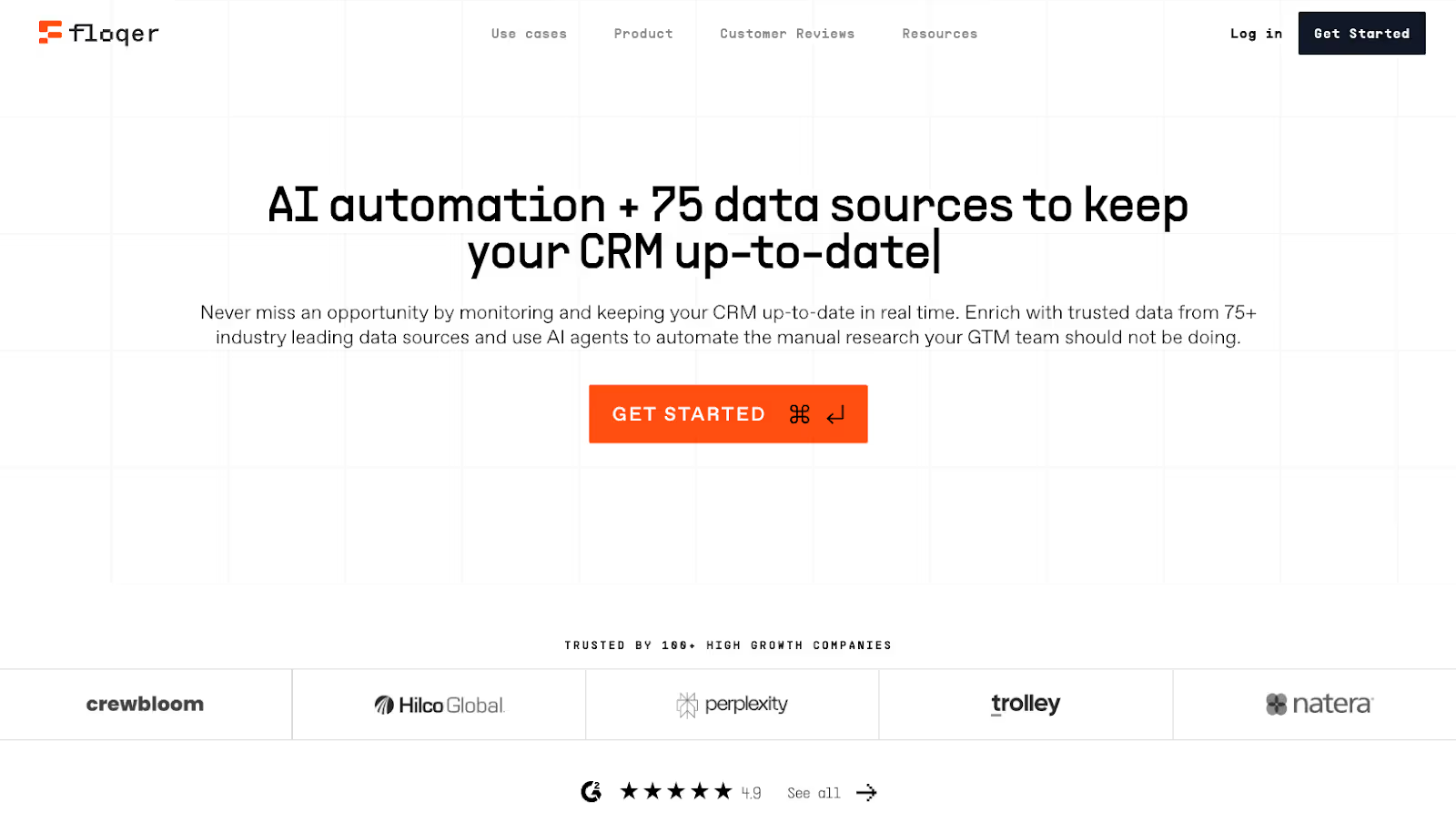
Floqer is an AI-powered GTM platform built to enrich CRM records and keep them clean, consistent, and up to date. Rated 4.9/5 on G2, it’s ideal for RevOps, Marketing, and Sales teams that prioritize accuracy, broad data coverage, and hands-on support.
Why Floqer is a good alternative to Clay
- Purpose-built for CRMs: native integrations with HubSpot, Salesforce, and Zoho keep records clean with automatic de-duplication
- Chrome extension for instant, in-context account and contact insights
- 80+ data sources (including LinkedIn Sales Navigator) power accurate employee lookups and niche data coverage
- Easy to use yet powerful: build custom workflows and automate outreach with AI agents
- Seamlessly connects with Factors
Limitations
- Does not offer a free plan, it is built for teams investing in premium data; best fit for mid-market and enterprise.
- According to G2 reviews, few niche features are missing, but fast shipping closes gaps quickly.
Pricing
Floqer’s pricing starts at $999/month, including full support.
Factors + Clay: A new era of outbound sales
What’s the one thing that can take your sales strategy to the next level? Two words: Intent data. When you combine Clay’s enrichment solution with Factors’ intent signals, you get a complete view of in-market accounts, thereby allowing you to refine your outreach strategy.

Check out our Factors x Clay playbook to understand how to make the most of both platforms and supercharge your outbound motion.
{{INLINE_CTA_A}}
Choose the best Clay alternative today
With so many tools in the market, finding the right contact enrichment tool can be tricky. You must ensure that you choose the right sales prospecting tool that offers accurate information and can be adopted by everyone on the sales team.
%20(1).png)
Top Koala Alternatives to Consider in 2025
Update: Koala’s been acquired!
In a recent development announced on July 18, 2025, Koala was acquired by Cursor (parent company Anysphere). The platform will officially shut down by September 2025, despite having raised a $15 million Series A funding earlier this year.
Koala’s founding team is now working closely with Common Room to help customers transition, with Common Room even matching Koala’s existing pricing tiers for equivalent feature packages.
If you’ve come across this article, chances are you’re exploring intent data platforms that can help you generate pipeline and strengthen your GTM motion. You’re in the right place as we’ve rounded up the best alternatives you can consider this year.
| Feature Category | Factors.ai | Others (at a glance) |
|---|---|---|
| AI Agents & Actionable Insights | ✅ Real-time alerts, enrich leads, trigger campaigns automatically | Most tools only provide alerts or data enrichment; limited execution |
| Custom GTM Workflows / Milestones | ✅ Dedicated support builds workflows, funnel stage analytics, prioritize plays, tailor messaging, validate experiments | Rarely available; other platforms mostly pre-built automation |
| Account & Contact Scoring | ✅ Prioritize by ICP fit, funnel stage, and intent intensity | Mostly missing or limited scoring |
| Multi-Source Intent Data | ✅ Website, CRM, ads, LinkedIn, communities, product usage | Often single-source or anonymous signals only |
| Customer Journey & Timelines | ✅ Chronological view across all touchpoints, full visibility of funnel progression | Partial or limited insights in other tools |
| Person-Level Identification | ✅ Pinpoint likely visitors (~30% coverage) using geo, job title, company, persona | Mostly anonymous or partial enrichment |
| Dynamic Ad Activation & Google Integration | ✅ Sync audiences to LinkedIn/Google Ads, Google CAPI, ICP-targeted campaigns | Rarely available in other tools |
| Multi-Threading & Buying Group Identification | ✅ Identify and engage multiple decision-makers | Rarely available |
| AI-Driven Contact Insights | ✅ Surface right contacts, generate personalized outreach insights | Most tools only enrich data, no actionable recommendations |
| Slack / MS Teams Alerts | ✅ Instant notifications for high-intent actions like demo visits or pricing page revisits | Limited or unavailable |
| Ease of Use / Unified Platform | ✅ Single dashboard; all GTM execution, analytics, and alerts in one place | Others often require multiple tools or steep learning curves |
5 Factors to consider when looking for a Koala alternative
- Robust integration options: Since Koala only offers integrations to Hubspot, Salesforce, and Apollo, you must look for a tool that seamlessly integrates with your existing tech stack.
- Custom workflow automations: Find a tool that allows you to build custom workflows that automate your sales and marketing processes across your CRMs to save time.
- AI-powered insights: Don’t just consolidate data and reports; understand the ‘why’ behind your numbers and learn how you can improve with AI-powered insights.
- AI Agents: Look for AI agents that can take action on these insights, automatically triggering alerts, enriching leads, or launching campaigns, so your team can focus on strategy, not manual busywork.
- Extract intent data from multiple platforms: Your prospects conduct research beyond your website before they make a purchase. Invest in a solution that gives you intent signals from relevant sources such as LinkedIn, review sites, communities, and the like.
Top Koala Alternatives
Factors.ai
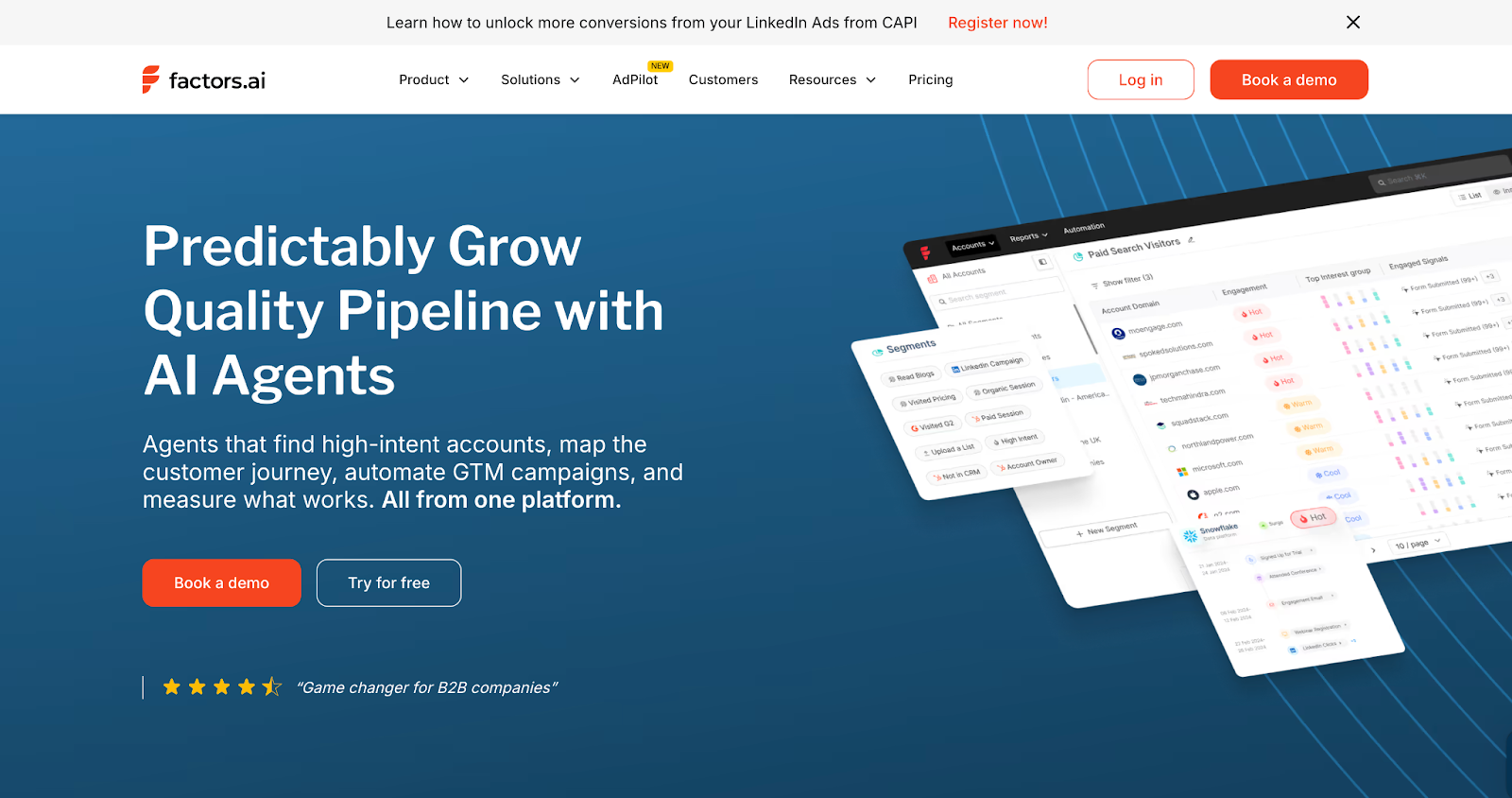
Factors.ai is designed to help B2B teams grow a quality pipeline with AI Agents, from identifying high-intent accounts to mapping the customer journey, automating GTM campaigns, and measuring what works. Everything happens in one unified platform, making it easier for sales and marketing teams to act on intent signals in real time.
Core Offerings
- GTM Engineering
- Dedicated support team builds custom workflows.
- AI Agents alert reps in real time, pull account research, identify and multi-thread buying groups, revive closed-lost deals, and track post-meeting engagement.
- Milestones: Funnel stage analytics show which actions and content drive stage progression. Helps prioritize plays, tailor messaging, diagnose drop-offs, and validate GTM experiments.
- Account 360: Unified view of all sales and marketing touchpoints. Aligns GTM teams and ensures no high-intent account slips through the cracks.
- AI Alerts: Real-time alerts for optimal outreach. Includes closed-lost reactivation, form-fill drop-offs, and post-demo browsing history.
- Google CAPI: Sends richer conversion signals to Google Ads, optimizing for high-value accounts rather than low-quality leads.
- Google Audience Sync: Retarget ICP-fit accounts, suppress low-value clicks, expand keywords safely, run buyer-stage campaigns, and refresh audiences daily.
- Account & Contact Scoring: Prioritize accounts by ICP fit, funnel stage, and intent intensity.
- Customer Journey Timelines: A Chronological view of buyer actions across the website, ads, product, and CRM.
- AI-Driven Contact Insights: Surface the right contacts, generate personalized outreach insights, and monitor deal progress.
- Dynamic Ad Activation: Sync audiences to LinkedIn and Google Ads for efficient targeting, in-funnel retargeting, and ABM campaigns.
- Slack/MS Teams Alerts: Instant notifications for high-intent actions like demo visits, pricing page revisits, or document views.
- Multi-threading & Buying Group Identification: Engage multiple decision-makers to reduce deal risk.
- Person-Level Identification: Pinpoint likely visitors without invasive tracking using geo, company, job title, and buyer persona filters (~30% coverage).
Limitations
- Factors doesn’t offer information at a user level due to privacy and compliance regulations.

Pricing

Common Room

Common Room is a natural fit as Koala’s team has partnered with the company to support users during the transition. It pulls in intent signals from social platforms, communities, CRMs, and more. Best of all, it’s honoring Koala’s pricing tiers to make the switch smooth and budget-friendly.
Core Offerings
- RoomieAI™ Capture: Always-on AI agent that tracks 50+ signal sources, like product usage, website visits, and social activity, to surface warm prospects in real time.
- Person360™ Enrichment: Industry-leading AI-powered waterfall enrichment and identity resolution that turns anonymous signals into fully identified accounts and unifies the buyer journey.
- RoomieAI™ Activate: Automates outbound campaigns and personalizes messages based on context from buying signals, turning every rep into a top performer.
- Multi-Source Signal Integration: Pulls intent signals from social platforms, communities, CRMs, hiring trends, and dark funnel activity to ensure you never prospect cold.
Limitations:
- Navigation isn’t intuitive. Many users find the interface steep and challenging to use without dedicated onboarding or support

- Lacks built-in A/B testing and advanced analytics as users have flagged limited in-platform customization, especially around workflow edits and analytics depth

Pricing
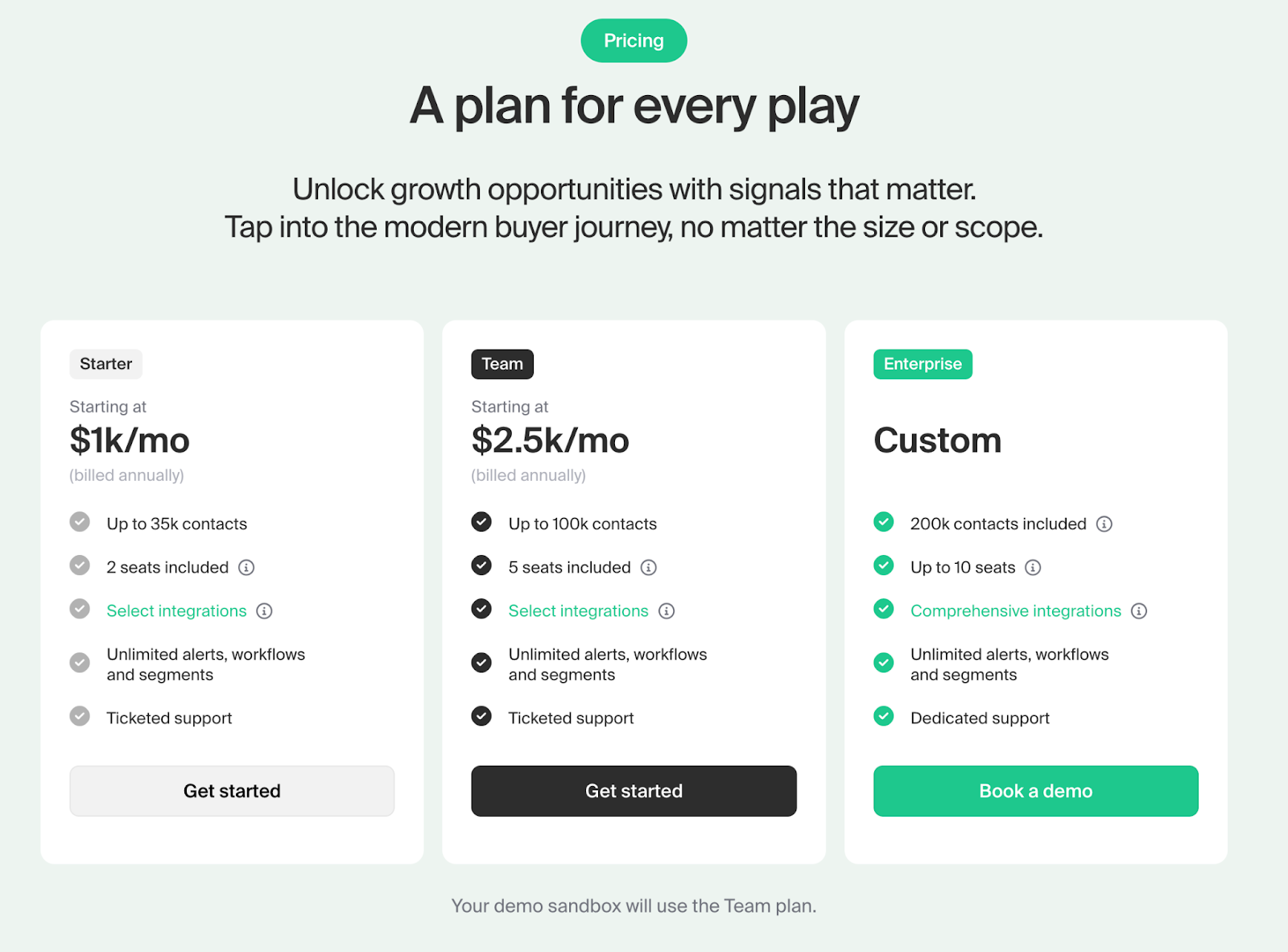
Clearbit
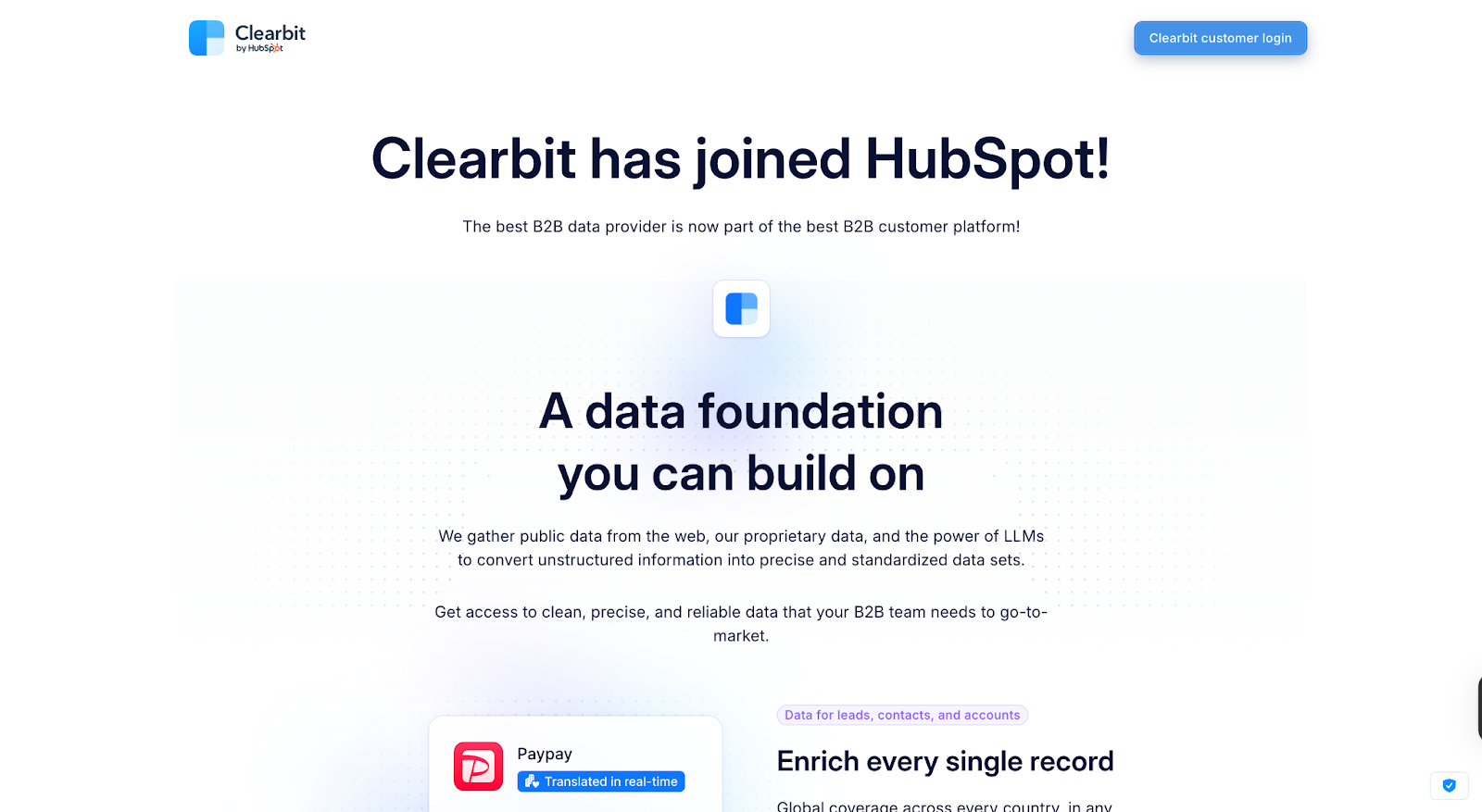
Clearbit, now a part of HubSpot, is a data enrichment platform that helps businesses get clean, reliable, and standardized customer data. It gathers information from public sources, its own proprietary data, and AI models to build precise datasets that B2B teams can use to go-to-market more effectively.
Core Offerings
- Data Enrichment: Enriches records of leads, contacts, and accounts with accurate, global coverage.
- Lead Scoring and Routing: Helps teams score and route leads in real-time using granular industry info, corporate hierarchies, and role/seniority mapping.
- Intent Tracking: Identifies anonymous website visitors with IP intelligence and highlights companies that match your ICP.
- Dynamic Form Shortening: Reduces form fields by auto-populating details, so users only need to enter essentials like an email address.
Limitations
- The credit-based pricing model can be confusing, as costs vary depending on usage.
- Setup can be tricky, especially for features like form shortening that often need developer support.
- Since it is now part of HubSpot, standalone use is limited, which can be restrictive for teams not using HubSpot.
Pricing
Clearbit doesn’t list its pricing publicly. For exact costs, businesses need to get in touch with their sales team.
Leadfeeder (now Dealfront)
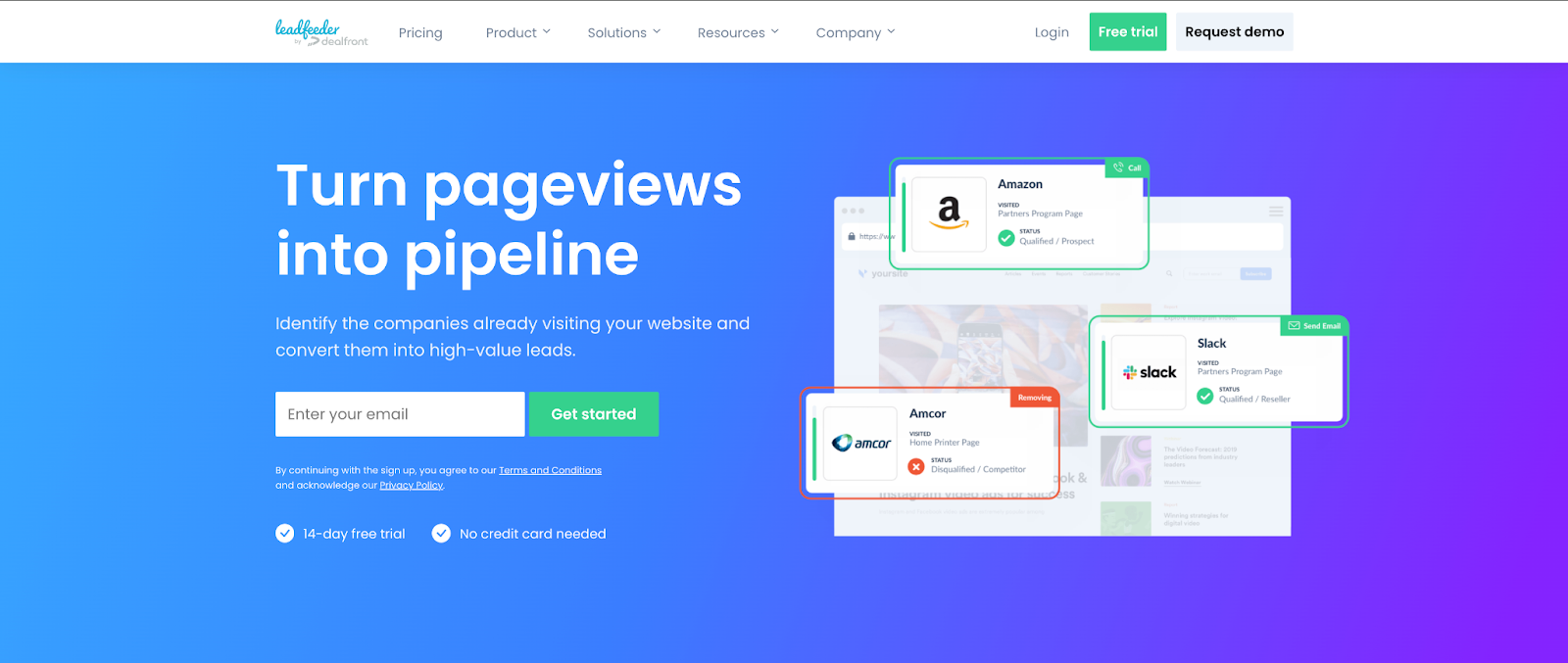
Leadfeeder (now known as Dealfront) identifies anonymous companies that visit your website and turns them into leads for your sales team.
Core Offerings:
- Website Visitor Identification: Transforms anonymous visitors into company names, revealing who’s exploring your site even without form fills
- Behavioral Tracking: Monitors pages visited, time spent, and browsing patterns to understand visitor intent.
- Smart Filters & Custom Feeds: Allows segmentation of visits by criteria like geography, industry, campaign, or engagement, with customisable feeds.
- Real-Time Alerts & Notifications: Sends instant alerts (via email or Slack) for new or returning visits, helping reps act quickly.
- CRM & Analytics Integration: Syncs visitor data with CRMs (e.g., Salesforce, Pipedrive) and tools like Google Analytics and Looker Studio for seamless follow-up and reporting.
- Lead Scoring & Prioritization: Automatically ranks leads based on engagement and firmographic data to surface high-intent companies.
Limitations
- No mobile app, and no real-time tracking for free users (updates hourly/below). Dealfront Help Center
- Customer support is often slow or unresponsive, multiple users report delays and poor resolution when seeking help

Pricing
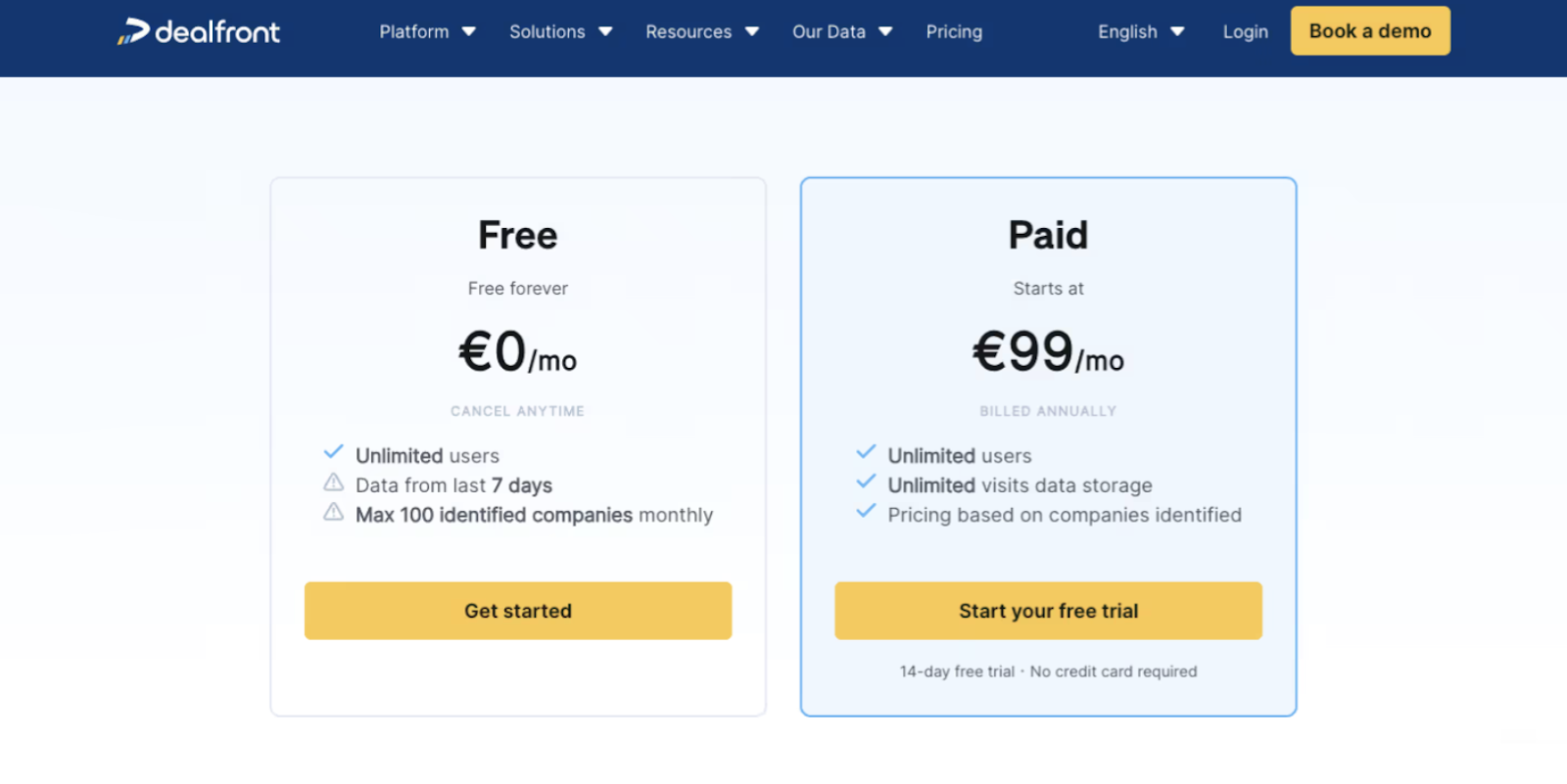
Also read: 5 Leadfeeder Alternatives For Visitor Identification In 2024
Lead411
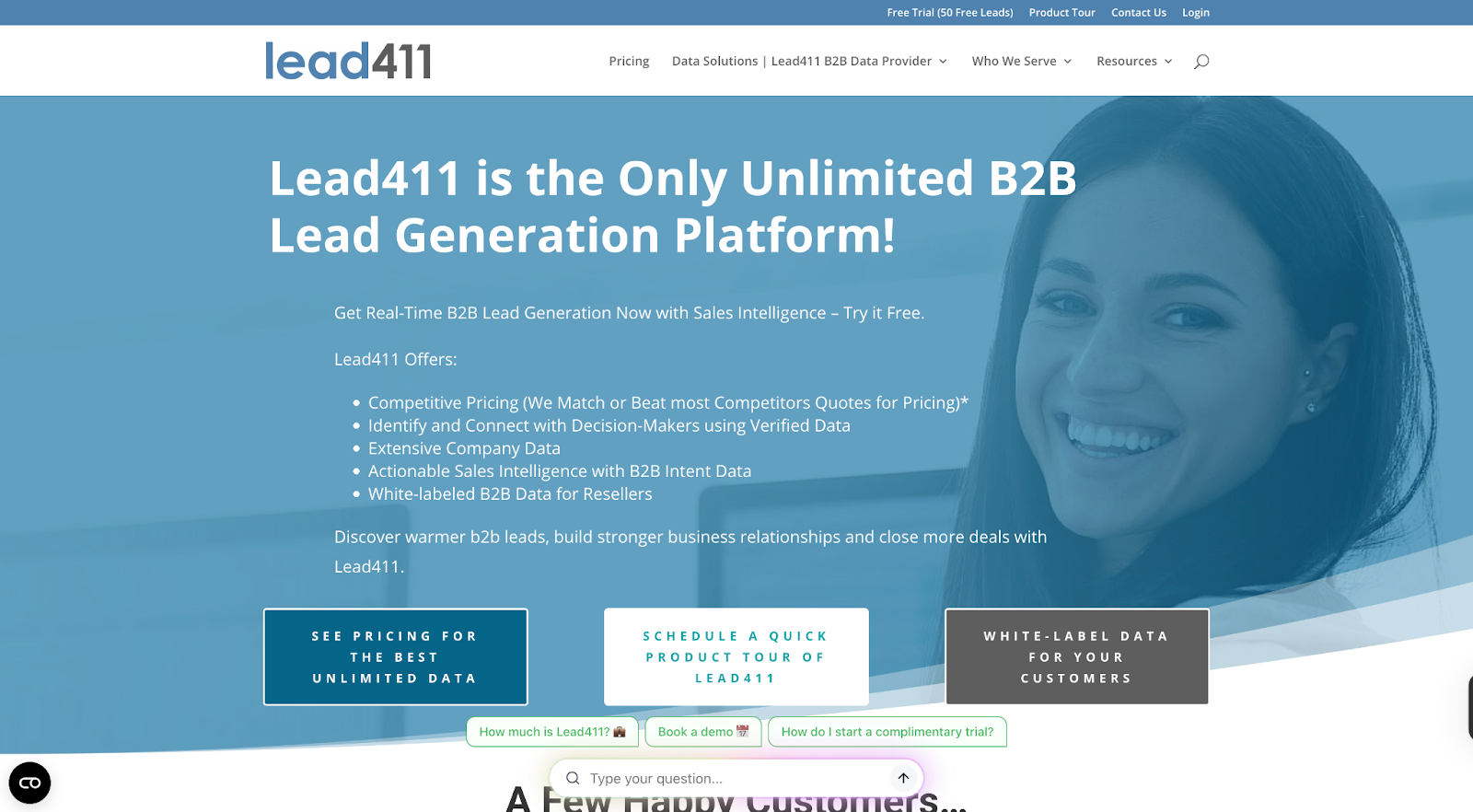
Lead411 is a B2B data provider that delivers insights into potential buyers by leveraging verified contact information and buyer intent data from Bombora. It’s designed to help businesses identify and connect with prospects who are actively showing interest in their products or services.
Core Offerings
- Intent topics: You can classify and set between 5-25 intent topics.
- Lead prospecting: Lead411 has an in-built prospecting tool to streamline the outbound process.
- CRM Enhancer: Automatically update your CRM with the latest data.
Limitations
- Users have found that even verified contacts may not be accurate at times

- The data can be difficult to manage because the platform doesn’t have the capabilities to sort it out into multiple manageable lists.

Pricing

Snitcher
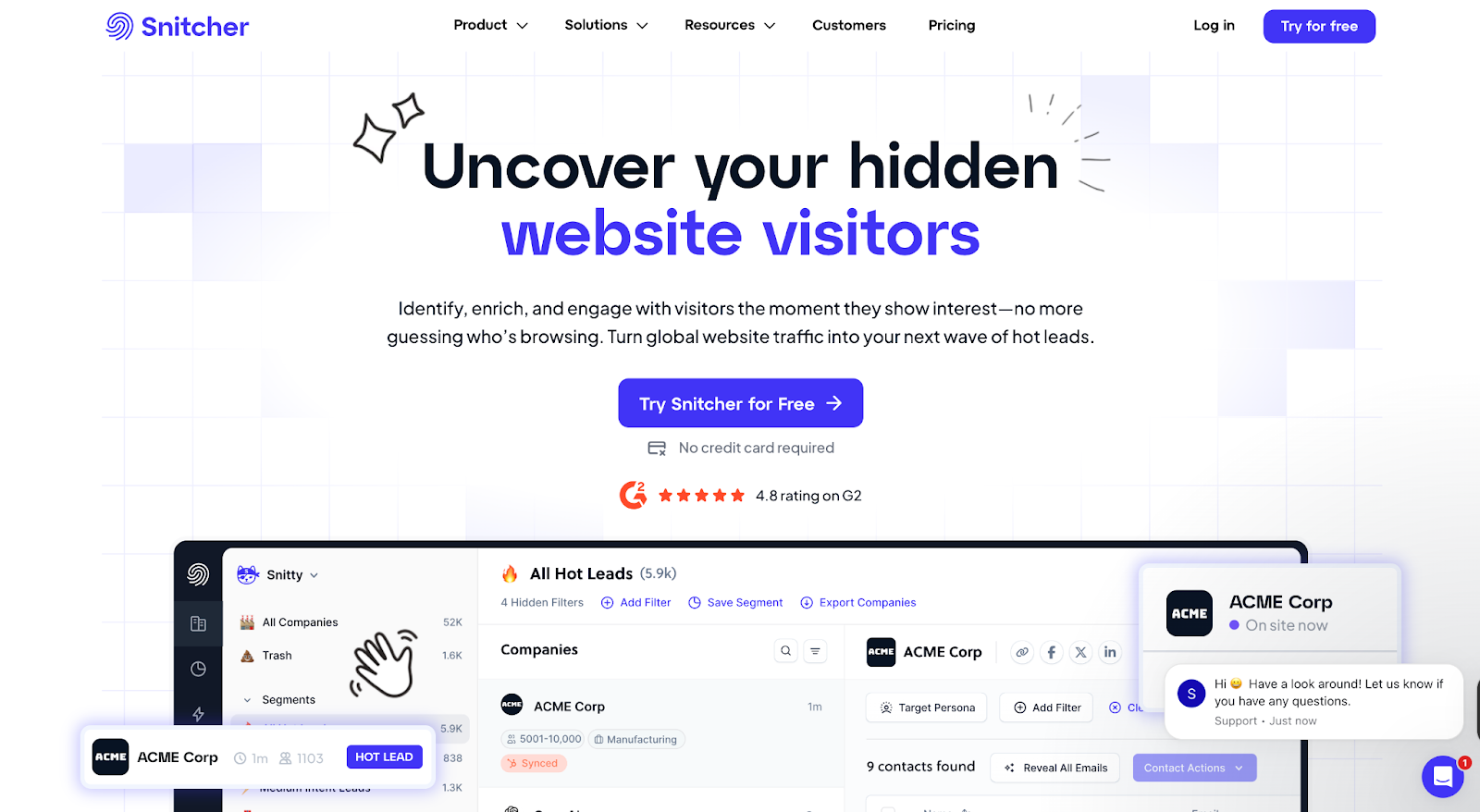
Snitcher unmasks anonymous companies visiting your website. The platform helps you understand their interests and convert them into qualified leads by tracking visitor behavior and enriching leads with details.
Core offering:
- Website deanonymization: Sintcher’s “identify” turns your anonymous website traffic into actionable leads and information in real-time.
- Google Analytics enrichment: Snitcher adds context to Google Analytics data by enriching the numbers with company identifications.
- Lead segmentation: You can segment your leads into audiences and run relevant marketing campaigns.
Limitations
- Users have reported that the filtering setup can be improved to navigate the platform easily.

- The pricing is higher than most account intelligence tools since they charge with usage-based pricing

Pricing

Warmly

Warmly is an AI-powered sales orchestration platform that identifies anonymous website visitors, captures buying intent, and engages them automatically.
Core offerings:
- AI SDRs & AEs that run personalized outreach across email, LinkedIn, and chat.
- Multi-threaded engagement to scale conversations without extra headcount.
- Website chatbots that proactively engage visitors using real-time company data.
- Tech stack orchestration with Salesforce, HubSpot, LinkedIn, Slack, and more.
Limitations
- If you’re looking for a product with more marketing-related use cases, Warmly may not be the best option.
- The pricing is higher than most of the tools on this list. Users have stated that it’s a huge jump from the free plan

Pricing
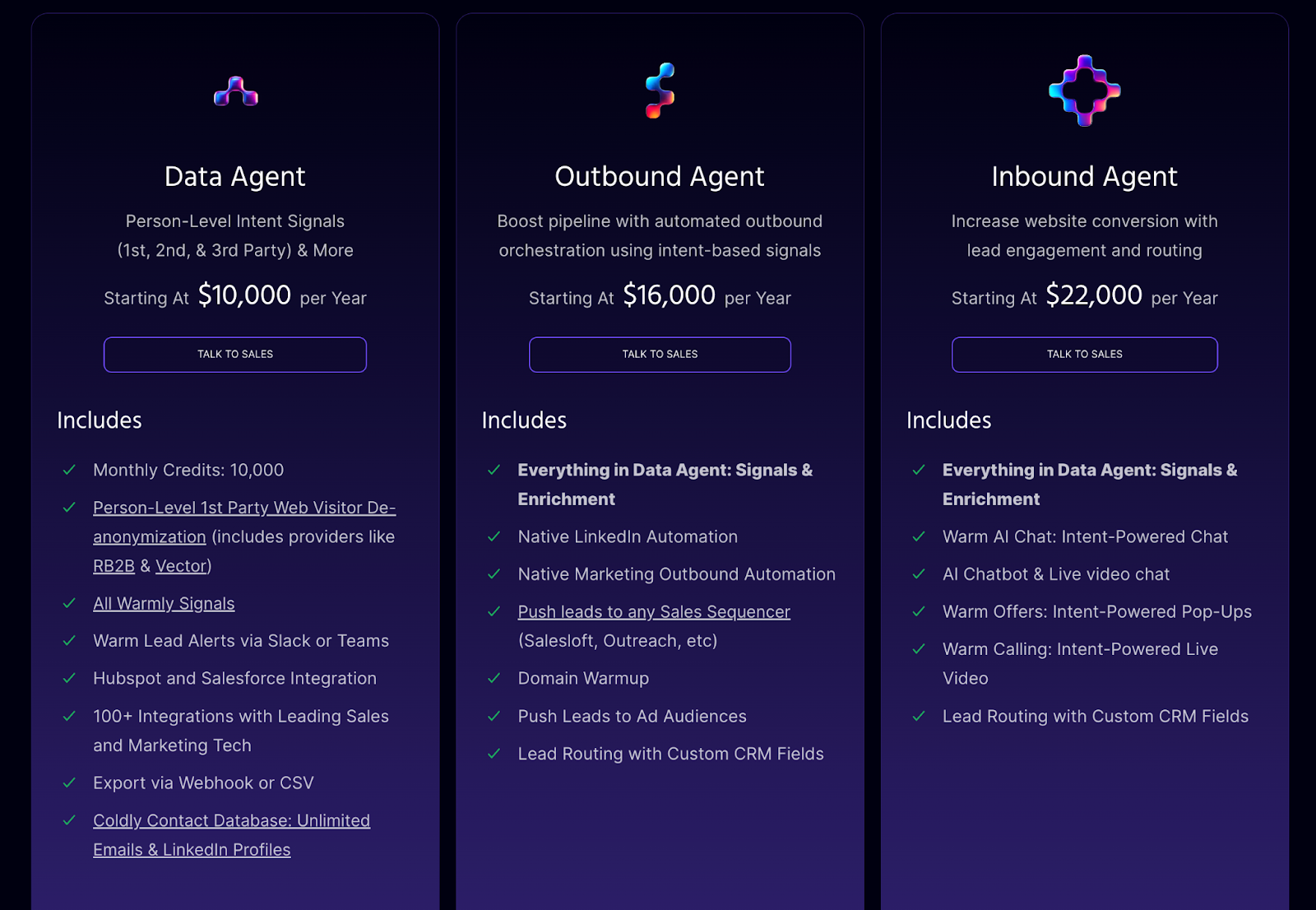
Zoominfo
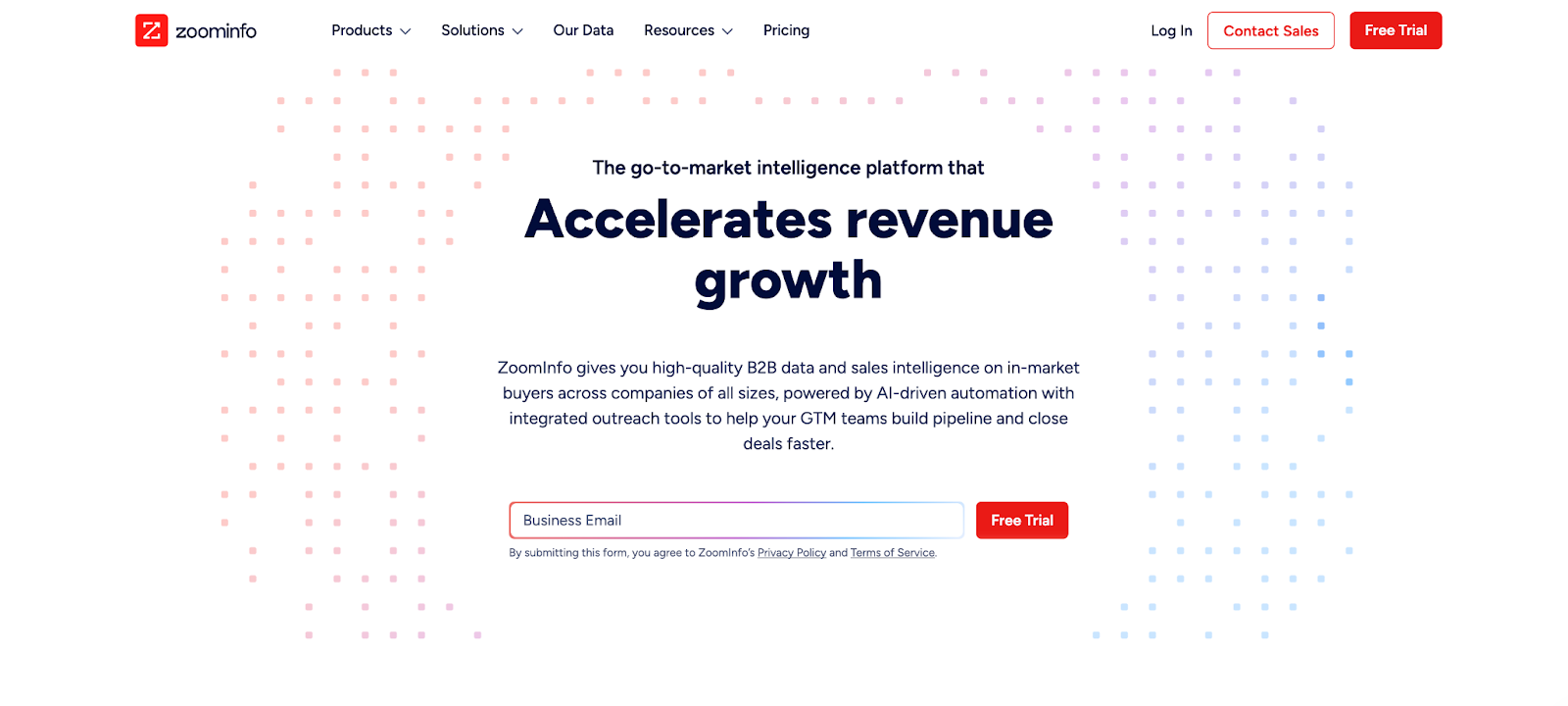
ZoomInfo is a comprehensive B2B go-to-market platform that combines AI-driven automation with SalesOS, MarketingOS, and Copilot features to help sales and marketing teams identify high-intent prospects, enrich their CRM, and orchestrate multi-channel outreach. And for those needing a heavyweight, all-in-one GTM platform, ZoomInfo remains the most established player
Core Offerings:
- AI-Powered Account Intelligence: Use real-time insights to uncover key decision-makers, organizational changes, pain points, and usage trends, helping teams prioritize high-value accounts and expansion opportunities.
- CRM & Tech Stack Enrichment: Automatically enrich and cleanse contact and company records across your CRM and tech stack, keeping data accurate, compliant, and always sales-ready.
- Multi-Channel Outreach: Coordinate campaigns across email, LinkedIn, chat, and other channels, guided by AI-driven prioritization and buyer intent signals.
- Workflow Automation: Automate repetitive tasks, from lead routing to campaign execution, so reps can focus on building relationships and closing deals faster.
Limitations
- Multiple users on G2 have stated that the tool has a steep learning curve, which isn’t ideal for agile marketing teams who want to use the platform for their day-to-day activities
- The contacts provided by the tool could be outdated, thus hampering your outreach efforts

Pricing
Since Zoominfo doesn’t publicly display its pricing, you can learn about it here: ZoomInfo Pricing, Alternatives & Overview
Pocus

Pocus is an AI-powered revenue intelligence platform built for product-led growth (PLG) teams, combining product usage data, CRM insights, and buyer intent to surface high-value opportunities and automate workflow.
Core Offerings:
- Unified Account Intelligence: Aggregate internal and external signals, including product usage, emails, CRM notes, and structured/unstructured enablement content, to understand your accounts deeply and provide actionable insights.
- Timely Alerts & Smart Nudges: AI agents monitor accounts 24/7 to highlight relevant events like promotions, product launches, or strategic shifts, ensuring reps focus on the highest-intent opportunities without signal overload.
- Prescriptive Guidance & AI Recommendations: Suggests next-best actions, org charts, and engagement strategies while generating AI-powered drafts for LinkedIn, email, and cold call scripts, keeping reps focused on closing deals.
- Action Integration: Eliminates tab toggling and manual copy-pasting, allowing reps to act on insights with one click directly within Pocus.
- Customizable Playbooks: Tailor workflows to your GTM motion with PLG-specific playbooks, automating first-level reasoning, and scaling personalized engagement across accounts.
Limitations
- If your company doesn’t lean into product-led growth, Pocus may not be the best fit.

- Many users point out problems like inaccurate data, mismatched details, and system bugs that make the platform harder to use

Pricing
As of now, Pocus does not publicly disclose its pricing information on its website. Check out their website for more.
Clay

Clay is an AI-powered workspace for prospecting that centralizes data, automates workflows, and helps GTM teams act on high-quality insights without bouncing between tools.
Core Offerings:
- Multi-Provider Data Enrichment: Access and combine data from 130+ sources, including contact information, firmographics, technographics, funding, and more, to ensure comprehensive lead coverage.
- AI Research Agents: Automate research at scale with agents that can flag fraudulent domains, summarize documents, score leads, and enrich SMBs, turning raw data into actionable insights.
- Intent Signal Tracking: Monitor customer events like job changes, promotions, funding announcements, and product news in real time, so you can time outreach perfectly and never prospect cold.
- Flexible, Automated Workflows: Build iterative GTM workflows with AI-powered conditional logic, routing, and multi-channel actions to push enriched data into any CRM, email sequencer, or other tool in your tech stack.
- CRM Enrichment & Maintenance: Keep your Salesforce or other systems up-to-date automatically, saving hours of manual work while improving outbound performance and campaign accuracy.
Limitations
- Clay uses credits for actions, which can get expensive as you scale.

- Steep learning curve for new users, many users find the platform complex and overwhelming until they're familiar with workflow logic and table structures.

Pricing
Clay offers credit-based pricing model without long-term contracts. For more, check their website.
Visitor Queue
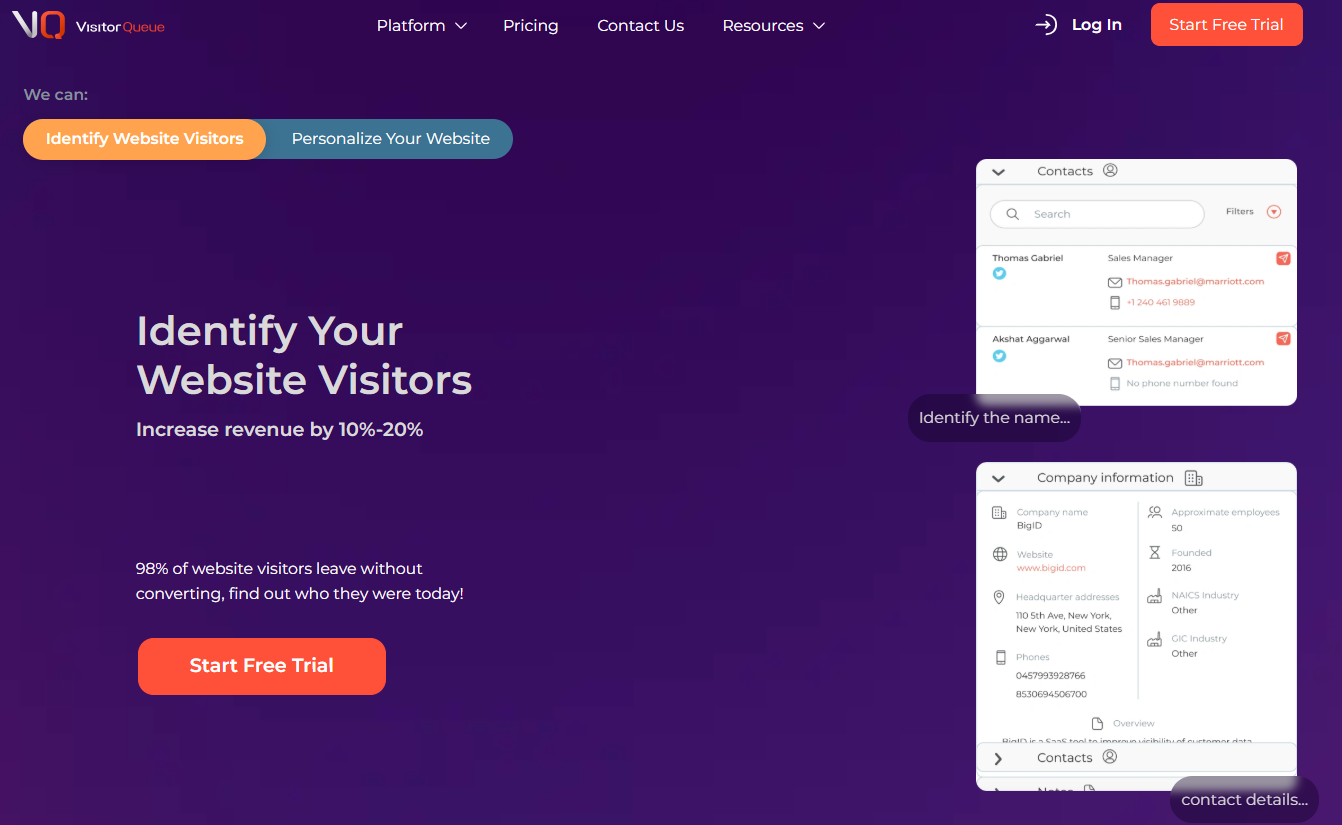
Visitor Queue is a B2B lead generation and website visitor tracking tool that identifies the companies visiting your website and shows what pages they viewed, how long they stayed, and where they came from. It’s a user-friendly, SMB-focused alternative used by companies in sales, marketing, and demand gen teams.
Why Visitor Queue is a good alternative to Koala
Visitor Queue is ideal if you're looking for a simpler, budget-friendly tool with strong lead enrichment features.
Its native integrations with CRMs like HubSpot and Salesforce make it easy to push account data into your pipeline without manual effort.
You also get access to firmographic filters to qualify leads faster.
Limitations
- There are fewer advanced features for deeper funnel analysis.
- UI and report customization options are limited compared to enterprise-level tools.
Pricing
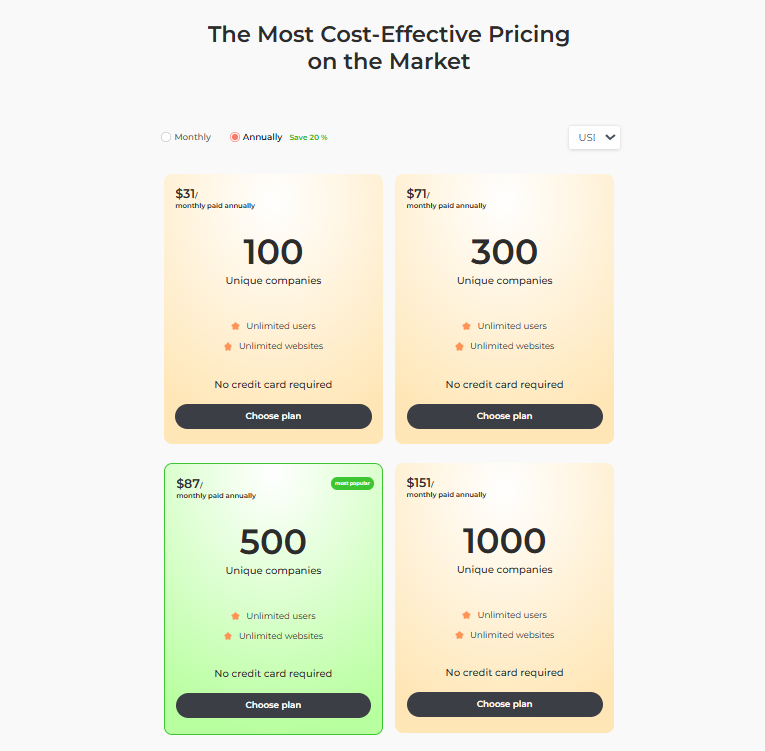
Why Factors is the Best Koala Alternative
If you’ve scrolled through this list, you might be wondering: “With so many options, what tool should I choose?” Well, Factors is a great choice here. Why? Because all the tools we’ve covered have their strengths, but Factors is built to solve real challenges B2B teams face every day, not just provide data.
With Factors, you’re not juggling multiple dashboards or piecing together signals from different platforms. Everything lives in one place, along with the AI Agents that take action on the insights. That means your reps get real-time alerts, enriched leads, multi-threaded engagement, and custom GTM workflows without manual busywork. The platform also gives you full visibility into the customer journey, scoring accounts, tracking funnel progression, and pinpointing high-intent buyers, all tailored to your ICP.
We get it, other tools can enrich data or alert you to anonymous visitors, but most stop there. Factors goes a step further, combining AI-driven insights with actionable execution. It’s not just about knowing what’s happening; it’s about knowing what to do next, and actually doing it.
In short, if your goal is to grow pipeline with confidence, automate tedious processes, and make smarter GTM decisions, Factors is designed to be your co-pilot, so your team can focus on strategy and revenue instead of manual tasks.
Speak to our team today to find out how you can best use intent data for your marketing campaigns.
In a Nutshell
Choosing the right intent data tool depends on your marketing goals and tech maturity. While Koala works well for early-stage companies, platforms like Factors.ai or Zoominfo offer broader insights, advanced automations, and deeper integrations. Explore each tool’s strengths before making your decision, your GTM strategy deserves it.
FAQs
What is Koala used for?
Koala is an AI-powered intent data platform that helps businesses identify high-potential prospects based on website activity and engagement.
Why look for a Koala alternative?
While Koala is a good entry-level tool, it lacks some features like multi-source intent signals, deeper integrations, and advanced workflow automation.
Which are the best Koala alternatives 2025?
Top Koala alternatives include Factors.ai, Clearbit, Lead411, Dealfront (formerly Leadfeeder), Warmly, Snitcher, and Zoominfo.
What features should I look for in a Koala alternative?
Key features include CRM integration, multi-platform intent signals (like LinkedIn or G2), lead scoring, enrichment, and customizable automations.
Is Koala suitable for enterprise marketing teams?
Koala may work for startups, but enterprises may find it limited in integrations, automation, and cross-platform intent visibility.
%20(1).webp)
Understanding Customer Churn Prediction in 2025
Imagine working hard for months to close the deal with a prospect, only for them to churn in less than a year. There could be several reasons, such as:
- Poor customer service
- Choosing a competitor's solution
- Users not achieving their KPIs
Reducing customer churn is vital for businesses because it ensures customer satisfaction and boosts profitability. The best way to avoid high churn rates is to predetermine the customers at a churn risk.
In this article, we'll detail how customer churn prediction is the key to reducing churn and keeping the cash flowing in 💸
What is Customer Churn Prediction?
Customer churn prediction involves analyzing data to detect customers likely to cancel subscriptions. SaaS businesses use this analysis to identify at-risk customers, leading to cost savings and improved customer lifetime value.
Analyzing churn through data-driven insights can help your business understand patterns and provide a roadmap for improvement. For example, if your surveys reveal that your platform has a complicated onboarding process – you can direct users to your onboarding specialist to assist them.

Why is Customer Churn Prediction important?
Losing customers is always costly. However, the costs involved go beyond the revenue lost from the customers who leave. It also includes the marketing expenses required to find new customers to replace the old ones. In many cases, the amount spent on acquiring a new customer is not covered by the amount paid during their time with the company. This means that customer acquisition is usually more expensive than customer retention.
Plus, unhappy customers share their experiences with others, impacting the company's reputation and customer acquisition budget. Businesses must predict churn and take action beforehand to prevent customers from leaving.
Once you know a customer is going to churn, you can take actions such as:
- Providing more targeted re-engagement campaigns
- Launching incentives such as loyalty programs that encourage them to stay
- Creating educational material that is tailored toward their specific needs
- Ensuring accessible and improved customer support
How to Build a Customer Churn Prediction Model
Creating a churn prediction model can help businesses retain customers and sustain growth. Using data analytics and machine learning, companies can identify which customers are likely to leave and take action to prevent it.
Here are the key steps to develop an effective churn prediction model ⬇️
- Data collection and review
Ensure that the data is accurate by handling missing values, removing duplicates, and converting it into a suitable format for analysis. Before moving on to calculations, reviewing the data for accuracy and validity is crucial. Every piece of customer info is valuable in the upcoming churn calculations, so it's worth ensuring accuracy.
- Model selection
Select an appropriate machine learning algorithm for churn prediction, such as logistic regression, decision trees, random forests, or gradient boosting machines. Split the data into training and testing sets, train the model, and tune hyperparameters to optimize performance. Evaluate the model using testing data and cross-validation. Deploy the model into production to make real-time predictions and prevent churn.
- Use an automated predictive model
Do people with lower NPS scores tend to leave more? Are they evaluating competitor solutions? You can predict who might leave by spotting these signs in the data. You must use machine learning with a dataset containing all the information you have about customers who stayed and those who left. The algorithm learns from this historical data to understand how different factors relate to churn. Then, it can predict if future customers with similar behaviors might leave or stay.
💡Factors can help you identify customers evaluating competitor solutions by helping you track when they visit their G2 pages.
- Establish retention strategy
Optimize your retention strategy by prioritizing actions based on the probability of customer churn. When customers first sign up, use checklists and personalized help to ensure they understand and use the product. As they keep using it, watch out for signs they might leave. For instance, if they're not using a feature they need, you can send them helpful tips to get them back on track.
- Track results regularly
Continuously monitor the churn prediction model's performance and update it with new data periodically to ensure it remains effective as customer behavior evolves. Before introducing any further changes to your plan, collect enough data to measure the real impact of your efforts.
Your churn model will provide probabilities for various customer segments. It's essential to keep testing new strategies and recording the impact on these segments. While creating a mathematical model of churn requires time and resources from your team, each test can help you create a better model for the future.
6 Customer churn prediction best practices
Now that you know how to build a churn prediction model, here are a few handy tips you must remember to prevent customer churn:
1. Segment Customers
After obtaining your data, it's time to shift your focus towards the users and begin segmenting them. Since users have distinct needs and usage patterns, they don't churn for the same reason. Hence, it's essential to categorize them into separate segments. You can segment them based on their:
- Demographics, such as location, region, company size, and the year they signed up for your company.
- Behavior and usage, such as how often they log in, whether they use a particular feature more or less, or whether they have completed the onboarding process.
- Contract terms include pricing plans and whether customers signed up for a monthly, quarterly, or yearly deal.
You can design retention strategies and marketing campaigns tailored to specific customer segments by segmenting customers based on their churn likelihood and characteristics. Domain knowledge or clustering techniques can help you define meaningful segments.
2. Monitor product usage data of existing customers
Product usage data captures how and when customers use your software. Important data points include feature usage, customer behavior, clicks, and other metrics such as time-to-value and product stickiness.
To build an effective model, it's important to consider some key product usage data points such as:
- Monitor feature usage data to show users' engagement with your product's features, indicating popularity and relevance.
- Observe users’ actions within your product, like when they use it, how long they use it, which features they engage with, and how they progress through it.
- Track the number of times a user clicks or interacts with a UI element, such as a button, checkbox, text area, or menu.
- Track other product usage data such as time-to-value, product stickiness, interactions, and more.
3. Keep an eye on customer success metrics
Understanding your users' success with your product is crucial in determining if they will continue using it. Surveys such as NPS and CSAT can be used to measure customer success. An NPS score of less than 7 or 8 means you may need a win-back campaign or value incentive to change their attitude towards your product. NPS measures loyalty and willingness to recommend, while CSAT measures customer satisfaction. Conduct these surveys periodically to track customer success and satisfaction.
4. Gather customer feedback regularly
Apart from gathering feedback through conventional ways, you can use various other forms of customer feedback to gain insights into their experience with your product or service. For example, in-app surveys can provide you with contextual input from users. You can use them to find out about your customer's overall satisfaction with your product, their experience with a particular feature, any issues they may have faced, or even the features they would like you to add or implement. This can be very helpful in understanding the general sentiment of users and identifying areas of improvement or strengths.
To promptly address issues and demonstrate responsiveness to user input, incorporate real-time feedback loops within your product. Acknowledge the feedback received through in-app surveys and communicate any actions taken to address user concerns.
5. Enhance customer experience
You can streamline the customer experience using automated onboarding, self-service options, and personalized support. Furthermore, you should use customer feedback to identify areas of improvement and proactively address any customer dissatisfaction rather than reacting after the fact.
6. Improve customer service
Respond promptly to inquiries and complaints, offer helpful advice, and measure performance using metrics like support tickets, call center response times, and social media interactions. Monitor these metrics to gain insights into customer service trends and effectiveness.
Customer Churn Prediction: Key Steps & Benefits
Predicting customer churn helps businesses retain clients and reduce acquisition costs through data-driven strategies.
1. Key Steps in Churn Prediction: Data collection, feature selection, model selection (Logistic Regression, Decision Trees, Random Forests, Gradient Boosting), model training, and real-time monitoring.
2. Essential Features: Customer tenure, usage frequency, service interactions, and engagement metrics.
3. Strategic Benefits: Identify at-risk customers, implement targeted retention efforts, and enhance profitability.
Leveraging churn prediction models enables businesses to proactively improve customer retention and long-term growth.
Wrapping up
Reducing customer churn is crucial for businesses as it directly impacts long-term revenue, customer loyalty, and overall business stability. However, understanding why customers leave requires analyzing data and tracking various metrics over time. Effective churn analysis involves monitoring overall customer turnover rates and identifying factors contributing to attrition.
Businesses can use advanced analytics and machine learning techniques to identify potential churners and implement targeted retention strategies.

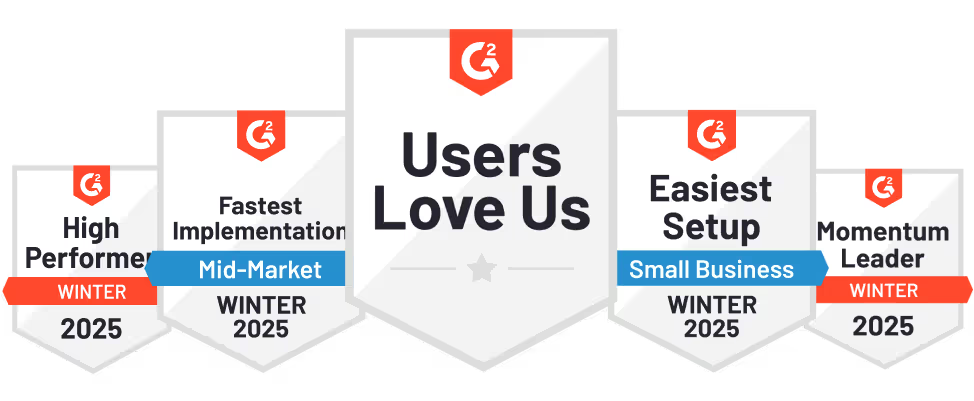
.svg)